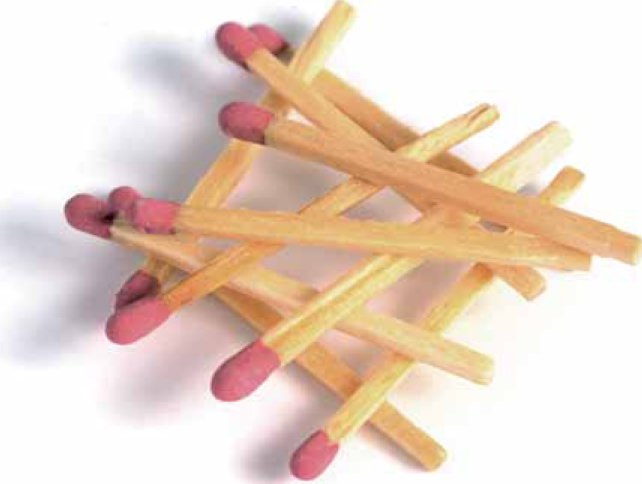Wood is not generally perceived as a material of mass production. Of course, it is used in all manner of high-volume products but not in the same way as moulded plastic or metal are, where identical parts come offa production line in their millions. Wood just isn’t seen as a material from which billions of identical products are produced. Ikea has wooden furniture, but the furniture is still assembled by hand. Here, however, is a wooden product that is as mass produced as a glass lightbulb and as abundant as a plastic ballpoint pen.
The matchstick, along with the toothpick, is high up in terms of stratospheric production volumes. The matchstick uses poplar’s ability to burn easily without producing toxins, and a lot of finely tuned production is involved in making just a single match. During the process there is no human contact with the products. First, the wood is cut into sheets of veneer, which are then chopped into square splints. The splints are then fed into a series of holes within metal plates, at a rate of approximately 40,000 matches every minute. These plates carry the matches through the various stages of production and the evidence of them can be seen at the base of every match – have a look for the rounded edge at the base of a match. The matches are dipped into a chemical bath to prevent afterglow when the match is burned, and then they are taken through paraffin to help them burn more easily. Machines can yield approximately 55 million units per day.
Image: Abundantly produced matchsticks

•448 kg/m3 (28 lbs/ft3)
•Pale colouring
•Tough for its weight
•Straight but woolly grained
•Good resistance to splintering
•Low resistance to shock
•Low stiffness
•Liable to insect attack
Sources
Europe, USA and Canada.
Cost
Poplar is relatively inexpensive.
Sustainability issues
Poplars are a fast growing tree, and therefore can be viewed as renewable under the correct forestry stewardship. They can also be grown in relatively poor soils and fully grown poplar are effective carbon sinks.
Production
Its straight grain makes poplar a wood that has good workability. however, it does have poor steam-bending properties. Staining poplar can produce patchy results.
Typical applications
Don’t let the use of poplar for matchsticks allow you to underestimate it. It has been used in far more tough applications, for example as break blocks for railway wagons, boxes and crates and also interior joinery and turned products such as toys. It is also a common veneer in the construction of plywood.
| + | – |
|
–Tough –Good resistance to splintering –Easy to work –Sustainable |
–Poor steam bending –Perishable –Low shock resistance –Poor finishing |
